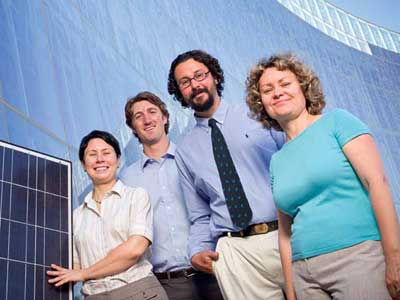Building a Better Power Grid: An international consortium studies microgrids
 “Buildings are the largest single consumer of energy —they use 77% of the electric energy in the U.S.,” says Andrea Mammoli, associate professor of mechanical engineering and co-director of the Center for Emerging Energy Technologies (CEET).
“Buildings are the largest single consumer of energy —they use 77% of the electric energy in the U.S.,” says Andrea Mammoli, associate professor of mechanical engineering and co-director of the Center for Emerging Energy Technologies (CEET).
Mammoli and an international consortium are developing ways for buildings to use energy more efficiently and more wisely. Their vision is to seamlessly align production of sustainable energy resources, including wind and solar, with energy needs in residential and commercial buildings.
Photo: Dr. Olga Lavrova, PhD student Birk Jones, Dr. Andrea Mammoli, and Dr. Svetlana Poroseva, part of an international consortium studying sustainability, in front of the Aperture Center at Mesa del Sol.
A Unique Opportunity
The consortium is Japan’s New Energy and Industrial Technology Development Organization (NEDO), which is working in partnership with UNM, Sandia National Laboratories, Los Alamos National Laboratory, and PNM, New Mexico’s largest electricity provider. With 21 American and Japanese companies involved, the NEDO-led project is the only one of its kind in the U.S.
The group is using Mesa del Sol (MDS), a master planned community in Albuquerque, to research the interface between buildings, distributed power generation, and the power grid. It’s also using MDS to test new smart grid technologies. MDS is a Greenfield development — undeveloped land without existing technology networks — designed for healthy, simple, sustainable living.
NEDO is creating a “microgrid,” a section of the power grid that can produce and store its own power through a mix of local renewable and fossil energy sources. The microgrid will be able to operate independently of the main power grid. Alongside the NEDO project, the DOE-sponsored PNM Prosperity Energy Storage project will test a battery the size of eight shipping containers that can store power generated by a photovoltaic plant.
Mammoli will study how buildings can absorb intermittent energy produced by solar and wind power. One strategy will be to use novel energy storage solutions and digital controls that manage power use based on demand and the status of local power generation.
The consortium plans to connect MDS’s flagship building, the Aperture Center, to the microgrid by the end of the year. At the same time, researchers will create a simulation of the grid to test different scenarios in real time without impacting buildings or residents. Ultimately, the simulation will be connected to actual buildings, allowing researchers to test the collective behavior of many smart buildings and observe the operation of real-life systems in detail.
Research will expand as MDS grows. When the two-year research project is complete, UNM will inherit the NEDO hardware (valued at more than $10 million), which will become a substantial component of a unique testbed that will put UNM at the leading edge of smart grid research.
Multifaceted Research Effort
Mammoli has assembled a multidisciplinary team to work on the project. Olga Lavrova, assistant professor of electrical and computer engineering, is modeling multi–agent behavior and analyzing the best way to configure an automatic system that includes many different nodes and controls. She is also modeling battery storage techniques to determine the best use of PNM’s giant battery.
As the research progresses, other faculty will get involved. Svetlana Poroseva, assistant professor of mechanical engineering, will use an approach she developed to find an optimal way for connecting buildings and power sources with one another so the microgrid will be more resilient against multiple failures.
Melanie Moses, assistant professor of computer science, will apply her expertise in biological systems to help design system architectures that are more resilient. And Tom Caudell, professor of electrical and computer engineering, will use his expertise in neural networks to develop ways of effectively monitoring these increasingly complex systems.
“The Smart Grid is a prototypical example of a complex problem that can only be solved with a multidisciplinary approach,” explains Mammoli. “At UNM, we have a team of faculty and students from many disciplines who interact to develop innovative solutions.”
